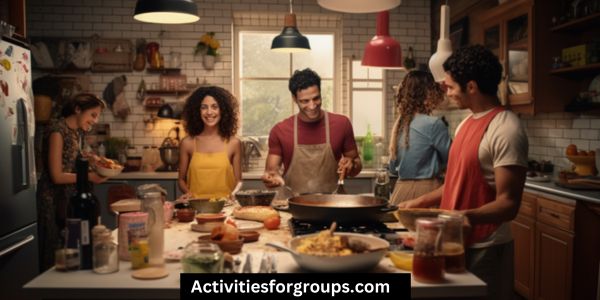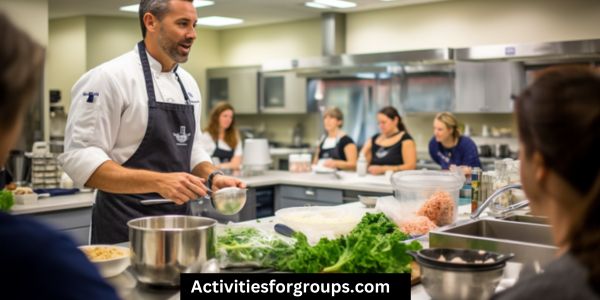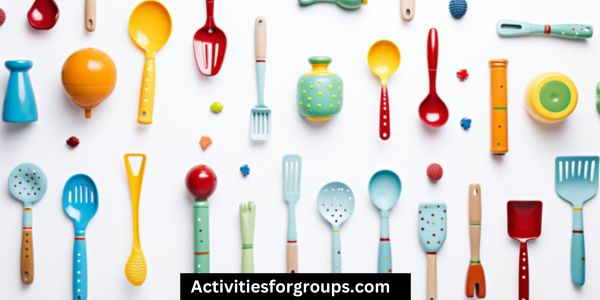Are you looking for creative ideas to organize a group cooking class? Look no further! Whether you’re looking for a fun activity for friends or a great team-building exercise, this article will provide the tips and tricks you need.

From choosing a theme and assigning tasks, to setting a budget and making a menu, we’ve got you covered.
Let’s get cooking!
Choose a Theme
A great way to make your cooking class unique is to choose a theme. The theme can be anything from a certain cuisine to a holiday or even a movie. Have your students design an outfit that reflects the theme, plan a party around it, and develop a recipe or two to go along with it. This will give them a unique experience and a great opportunity to learn about the theme in a fun and creative way.
The theme should also be something that your students are interested in, as this will help to keep them engaged and motivated throughout the class. Pick a theme that’s broad enough that it can be interpreted in different ways, but specific enough that it provides an interesting challenge. Consider the season, current trends, or even local culture when choosing a theme.
Once the theme has been decided, it’s time to plan the activities. Consider doing a taste test and having the students create their own recipes. You could also have them create a dish and discuss the various flavors and ingredients. If you decide to go with a party theme, have the students plan out the party decorations, food, and activities.
These creative ideas will help your cooking class stand out and give your students an enjoyable and educational experience.
Assign Tasks
Assign each group member a task to help make the cooking class a success. There are several areas that need to be addressed in order to make the class run smoothly:
- Sourcing ingredients:
- One team member can be responsible for gathering all the ingredients needed for the class.
- Another can handle the purchasing of any necessary kitchen tools or equipment.
- Divide responsibilities:
- Divide the tasks of preparing the food and setting the table between the group members.
- Ensure that each participant is assigned a task that matches their skill level.
- Manage timing:
- Assign a timekeeper to keep everyone on track.
- Make sure that the class has enough time to finish cooking before the end of the session.
By assigning specific tasks to each group member, it will create a more efficient and enjoyable cooking class.
Have a plan in place to make sure each person knows what’s expected of them and help them understand how their tasks fit into the bigger picture.
This will help ensure that the class runs smoothly and everyone has a successful and enjoyable experience.
Set a Budget

Decide on a budget for the cooking class that fits within the group’s means. Planning the expenses and shopping strategy can help keep the budget on track. To start, create a list of ingredients you’ll need to purchase for the class.
Consider the number of people attending, and how the dish will be served. Estimate how much money each ingredient will cost, and total the cost of all the ingredients. This will give you an idea of the amount of money you’ll need to set aside for the class.
You may also want to consider miscellaneous expenses, such as kitchen equipment rental, dishware, cleaning supplies, and any other items that may be required.
To stay within your budget, shop around for the best prices and look for discounts and coupons. You may also want to look into alternative sources for ingredients, such as local markets and small farms.
It’s important to have a budget in mind before the cooking class. Having a firm budget in place can help you plan for the class properly, and ensure that the group stays within their means. With proper planning and budgeting, the group can enjoy a fun and successful cooking class.
Make a Menu
Choose a few recipes for your group cooking class that will make the most of the available ingredients and time. To make the most of your planning logistics, consider the following:
- Shopping List:
- Make sure to get all the necessary ingredients in advance
- Consider what equipment is needed
- Order any extra items that may be needed
- Recipe Selection:
- Choose recipes that will match the skill level of the group
- Aim to select recipes that are healthy and budget-friendly
- Aim to select recipes that are simple yet varied
- Group Management:
- Assign tasks to each group member
- Establish timelines for each step of the recipe
- Establish safety protocols for using the equipment
Planning the menu for your group cooking class requires careful consideration of the available ingredients, the skill level of the group, as well as the logistics of the class. When done properly, the menu should be simple, budget-friendly, and varied.
Taking the time to plan out the shopping list, recipe selection, and group management tasks will help ensure a successful and enjoyable cooking class.
Have Fun!

Having fun is an essential part of any group cooking class! Incorporating team-building exercises can make the class even more enjoyable.
For example, you could have a team relay race to see who can chop the most vegetables or who can crack the most eggs in a minute.
This will get everyone involved and laughing. You could also set up a competition to see who can create the tastiest dish. Everyone can vote for their favorite dish and the winner can receive a prize.
You can also make the class more fun by adding music and having a dance party in between cooking tasks.
This will help to break up the monotony and inject some energy into the class. Additionally, you could have a potluck at the end of the class where everyone brings a dish to share. This will give everyone a chance to try dishes from around the world and make the class more interactive.
Frequently Asked Questions
What Is the Ideal Size for a Group Cooking Class?
The ideal size for a group cooking class depends on the kitchen layout and menu planning. Generally, 8-10 people is a good number to ensure everyone has enough space and can properly follow the recipes.
What Safety Measures Should Be Taken When Organizing a Group Cooking Class?
You should prioritize food safety and kitchen hygiene when organizing a group cooking class. Ensure all ingredients are fresh, surfaces are sanitized, and everyone wears protective clothing.
Is There Any Special Equipment Needed for a Group Cooking Class?
You’ll need to make sure you have enough equipment for everyone, as well as sanitizing surfaces and assigning roles. Consider providing aprons and utensils for each person so they can work safely and comfortably.
How Long Should a Group Cooking Class Last?
A group cooking class should last long enough to plan a menu, manage costs, and prepare the meal. Aim for 2-3 hours depending on the complexity of the menu.
What Are Some Recommended Recipes for a Group Cooking Class?
Plan a menu that suits your group and makes use of good time management. Consider recipes that can be prepped in advance and cooked quickly for the best results.
Conclusion
Organizing a group cooking class doesn’t have to be hard work. Choose a theme, assign tasks, set a budget, make a menu, and have fun!
With a little bit of planning, you can create an enjoyable and memorable experience for everyone involved.
So don’t wait – get cooking and make some lasting memories!




Leave a Reply